 The dilapidated buildings populating what once was the largest U.S. Army base in the western United States — Fort Ord — might seem like an ideal backdrop for a Hollywood director filming a post-apocalyptic movie, or maybe a modern-day version of “The Twilight Zone.”
The dilapidated buildings populating what once was the largest U.S. Army base in the western United States — Fort Ord — might seem like an ideal backdrop for a Hollywood director filming a post-apocalyptic movie, or maybe a modern-day version of “The Twilight Zone.”
They are drab and creepy, with broken windows, peeling paint and boarded-up doors, surrounded by ugly weeds, debris, litter and junk.
The interiors of those long-abandoned structures are without electricity — pitch-black and bone-chilling (both literally and figuratively), says Enid Baxter-Ryce, 40, chair of the Cinematic Arts and Technology Department at CSU Monterey Bay, where she’s been on the faculty since 2006.
In fact, when Ryce and her film students became intrigued by those buildings — and the stories they might tell, if the walls could talk — one of the things they playfully ordered off the Internet was a ghost-hunting kit.
“The kit came with an instruction manual — which terrified us — divining sticks, a thermometer to find cold spots, and an electromagnetic field sensor,” she said with a laugh Saturday at the Marina Library, where she presided over a multimedia presentation about a project called “Planet Ord,” a combination of photos (new and old), student films and Ryce’s own original artwork. “Those buildings haven’t had electricity for a decade and a half, but some of them set the electromagnetic sensor at ‘danger.’ ”
But Ryce and her students weren’t really looking for ghosts. They wanted to recapture some of the long-lost history of a base that prepared soldiers for battle in World Wars I and II, Korea and Vietnam.
The Army closed it down and sealed most of the buildings in 1993 — 30,000 people moved out in a single day — but when a local girl went missing in 1998, the FBI broke into every abandoned structure during its search.
“We explored every building, which was exciting and fascinating,” Ryce said. “I did it so you don’t have to. They’re not only dangerous, but they also smell pretty bad … and it’s also illegal now. You’re not allowed to go in.”
Among their many discoveries were murals — 583 were found during the project, and the count now exceeds 1,000, she says — painted by the soldiers who trained there, each one expressing the emotions of men who, most likely, were headed into battle.
Videos shot by Ryce’s students (which can be found at enviroartstumblr.com, planetord.com and enidbaxterblader.com) provide an eerie, flashlight-illuminated tour through dark hallways and rooms, interspersed in some cases with photos or footage of the same locations during Fort Ord’s heyday.
The project also includes emotion-charged interviews with veterans who did their basic training at Fort Ord, endured combat tours in foreign wars, and, in many cases, returned with post-traumatic stress disorder to a homeland where people seemed unappreciative — even unaware — of the sacrifices they had made.
But the interviews in “Planet Ord” also rekindle memories among the veterans of a time and place in their lives that remain meaningful decades later.
“A surprising thing happened when I got here,” says 80-year-old Greg Seastrom in a film made by his grandson, Lucas. “I found out that (Fort Ord) wasn’t nearly as bad as I had feared. I looked around and realized that Fort Ord is in a very, very beautiful place. One thing you learn very quickly in the Army is that you spend an awful lot of time standing around. And if I had to stand around, it was a pretty nice place to be standing around.”
The event at the Marina Library was the last in a series of presentations Ryce has made at local libraries, but she says she hopes to schedule more in the future.
Her website at www.planetord.com includes photos, short films, maps, anecdotes and a collection of stories about Fort Ord. Ryce’s original artwork will find a permanent home at the Seaside Public Library at the end of November.